
THE BLACK PRE-LAW ASSOCIATION PRESENTS


THE BLACK PRE-LAW ASSOCIATION PRESENTS
BLACK HISTORY MONTH ZINE: 1St EDITION


he Black Pre-Law Association is committed to the education of the legal system and how it impacts the Black community. We created the first ever undergraduate Black law journal at UCLA to inform not only the Black Bruin community, but the larger UCLA community. We cover a wide range of topics regarding laws, policies, legislations, and our government. Our law journal serves as a m otion to increase awareness on pressing issues and injustices within the Black community and what we can do going forward. As a pre-law organization, the current Presidents Kennedy McIntyre and Jayda Jackson have made a contribution and commitment to expanding th e pillars of BPLA and the BPLA Law Journal to discuss politics, policy, and government.
This law journal will serve as a part of their commitment to ma ke BPLA holistic in policy, government, and politics in addition to the law. We need a law journal that will cover the vast inequities that occur within our community and this is only part of the mission to make legal education accessible and a priority for our community. The Black Pre-Law Association is dedicated to uplifting and advancing our members in the area of professional, career, and personal development as well as community service. The Black Pre-Law Association Law Journal acts as a separate entity that is under the regular Black PreLaw Association, but will serve on the journalism and media side. Our members and executive board that serve on our Law Journal team will have the opportunity to enhance and develop their writing, crit ical thinking, data analysis, and research skills.
The Black Pre-Law Association will advance its law journal members and executive board to have career and professional development in the areas of law, journalism, and media. We are committed to connecting with other media organizations at UCLA to prepare our members with the correct training and mentorship needed to discuss law, politics, and our government. It is our duty to make not only Black UCLA students accessible to this information, but other college campuses and the larger Black communities in which our universities neighbor.


s we celebrate Black History Month, I wanted to take this opportunity to shed a positive light on the Black experience, specifically B lack joy. Many times, when we consume media about the Black community or Black life, we are faced with tragedy and challenges. While this is necessary for understanding the honest experiences of Black people around the world, I believe it is equally important to acknowledge the sac rifices and accomplishments of those who came before us. We are all products of our history, and it is important that we continue to learn about it—especially in times when we see patterns repeating themselves and the same stories unfolding. In my second year as editor-in-chief, I hope to use this Black History Month Zine as an opportunity to spread more joy in dark times, allowing it to serve as a light amid the darkness that may over shadow our daily lives. The Black experience can be painful, but it is also powerful and a symbol of resistance. Throughout the legal field, in gentrified communities, and across continents, we see the power of not only Black joy but also Black resilience, courage, and strength. I am incr edibly proud of our first-ever Zine Team and In-Design Team for their amazing work on this inaugural edition. I feel truly blessed to work alongside such talented students at this institution, and I am excited to continue ampl ifying the voices of Black Bruins throughout the rest of my academic caree r. As you read these pieces, I hope you gain knowledge and a deeper understanding of the power of Black joy. I hope that it brings you some joy as well! It is always an honor to serve as the BPLA Law Journal editor-in-chief, and I am so excited to share the first-ever BPLA Black History Month Zine with you all!
Ure Egu
BPLA Editor-in-Chief, 2023-2025
Happy Black History Month!

Black Pre-Law Association Statement of Purpose
Kennedy McIntyre & Cierra Anguiano | BPLA Co-Presidents
A Letter From the Editor
Ure Egu | Editor-in-Chief
Tug-o-War Revelation: Understanding Triple Consciousness
Precious Alagba | Staff Writer
Faith Ndegwa | Staff Editor
Alana Akiwumi | Graphic Design
The Lasting Impacts of Alpha Kappa Alpha in the 2024 Election
A’shiyah Dobbs | Staff Writer
Ure Egu | Staff Editor & Graphic Design
Parallel Pursuits of Justice
Anna James | Staff Writer & Graphic Design
Jenna Besh | Staff Editor
Thurgood Marshall and Brown v. Board of Education
Devin Anderson | Staff Writer
Meilani Maximo | Staff Editor
Shelby Solomon | Graphic Design
A Fight Against Gentrification: A Historical Counter Perspective
Bobbie Patton | Staff Writer
Thea Amadin | Staff Editor
Ure Egu | Graphic Design


Ure Egu | Editor-in-Chief
Political Science & African American Studies Major
Faith Ndegwa | Secretary
Public Affairs Major, African American Studies & Education Minor
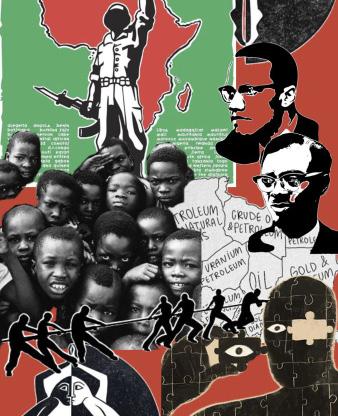
By Precious Alagba
child’s game, no?
20 arms, 2 teams, some ropes. Or is it rather… 500 some million arms, 8 teams. arms, 8 teams.
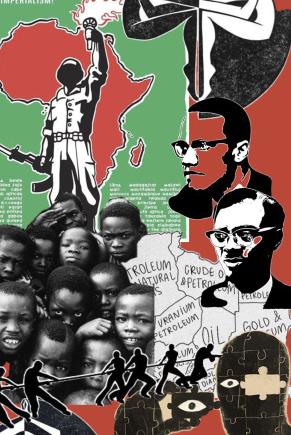
The rope is real and palpable, tugging at every fiber within a Black body whether consciously or not. Karl Marx and Friedrich Engels pioneered Dialectical Materialism, the theory that one’s physical world is defined through material and functional contradictions. W.E.B DuBois defined one of these tensions as Double Consciousness, the social philosophy of having two differing consciousnesses as a result of two identities (Bruce 1992). Compounding on Dubois’s concept, Triple Consciousness expands this framework to include the awareness of Black individuals, a Black individual in a colonial society, and being an African in Africa. As a result of colonial intervention, Africa was – and still is – widely homogenized, seen as a continent in need of saving from its own sin and savagery. While the colonial powers toyed with geopolitics and enriched themselves with Africa’s natural resources, they had not known their negligence of primordial margins created their own demise. By June 30th, 1960, the Democratic Republic of Congo had become Africa’s 19th independent country with Patrice Lumumba as its first prime minister. Congo:
In October of 1958, Patrice Lumumba, a mercurial yet determined man, and other Congolese leaders founded the Mouvement National Congolais, a political party advocating for Congolese independence, marking the beginning of their understanding of the force African Nationalism had truly become (Segantini 2023) When conflict arose over a mineral-rich province called Katanga and the United Nations (UN) refused to assist, Lumumba looked to the Soviet Union for aid. His rise to power terrified the UN and the United States, as his relentless pursuit of independence labeled him as dangerous. Lumumba strongly aligned with the ideologies of Black Nationalists, rejecting ethnic separation and supporting Pan-Africanism. His most notable proclamation was “positive neutralism”, the strengthening of a nations’ values and ignoring any foreign policies (Goshu 2016). He was in power for less than 10 weeks, his arrest and ill assassination followed quickly after his dismissal.
United States: Malcolm X
Thousands of miles away in the U.S., Black Americans fought a similar fight for their own rights. After the abolition of slavery in 1865, a century of systemic racial abuse followed in various forms, such as Jim Crow, forcing Black individuals to mobilize for their rights. Malik El-Shabazz, formerly known as Malcolm X, became one of the most influential figures, advocating for Black self-defense, economic autonomy, Black separatism, and Black nationalism while prioritizing racial unity and the liberation of Black people across the globe (Acholonu 2022). After his trips to Africa, X drew parallels between European imperialism and institutional racism, particularly in their methods of indoctrination and oppression. He stated in a 1964 OAU conference that issues in Mississippi would never “straighten out” without awareness of similar struggles in places like the Congo, highlighting a virtue of Triple Consciousness— that one mind cannot exist without the other (Acholonu 2022). Both movements interact with each other while tugging at the essence of all 200 million people within the African Diaspora.
Both men’s untimely demise were correlated to the Central Intelligence Agency (CIA), their dreams partially fulfilled. The unity of Black Nationalism can only be achieved once we cease the child’s game of Tug-o-War on opposing teams. Only by immersing oneself in the mantle of Black origin does one understand the Tug-o-War of Triple Consciousness. Their legacy seeps into every facet of Black life today, and in doing so, they shine in their time and illuminate the path for leaders that follow them across nations. We, as Black people. should tug together in efforts of understanding ourselves through concurrent consciousness, rather than accepting the imposed dichotomy the world attempts to put on the diaspora.
By A’shiyah Dobbs
This journal examines the pervasive punishment of individuals with darker skin perpetuate different types of anti-blackness
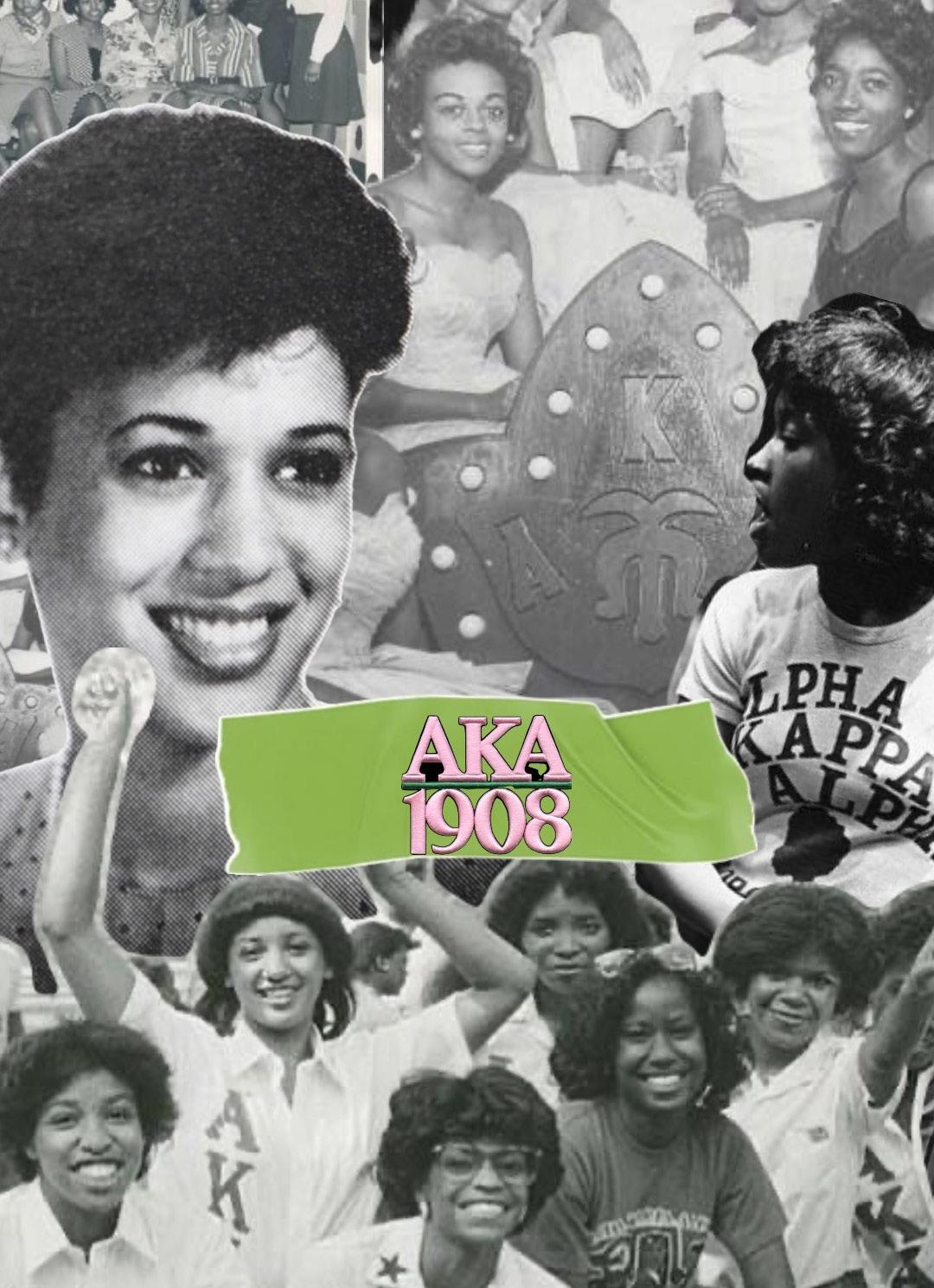


Introduction
Alpha Kappa Alpha (AKA), founded in 1908 at Howard University by Ethel Hedgemon Lyle and eight other collegiate women, is the first sorority established by and for African American women (Alpha Kappa Alpha Sorority, Inc.,2024, History). AKA’s mission has remained the same over the years, focusing on promoting high scholastic and ethical standards, fostering unity and friendship among college women, addressing issues affecting girls and women, enhancing their social status, and maintaining an interest in college life. Most notably, the sorority committed to being of “Service to All Mankind”(Alpha Kappa Alpha Sorority, Inc.,2024, About). This is seen in the sororities’ rich history of political engagement, activism, and social change which has continued to resonate with many of its members, including Kamala Harris, the first female African American Vice President of the United States. As a member of AKA, Harris’s connection to the organization illustrates its ongoing influence in shaping the political landscape. With a powerful network of women focused on social change, voting rights, and political engagement, their role in rallying voters and shaping the political landscape is vital. Examining AKA political involvement provides a unique perspective on how African American women, through organizations like AKA, will continue to shape the political future of the nation.
UCLA’s
UCLA’s Alpha Gamma Chapter of AKA at UCLA did various events leading up to the 2025 presidential election such as voter registration drives on Bruin Walk. During this they offered free donuts to those who registered to vote on the spot or checked their registration status and provided pamphlets with information on where to vote on Election Day, instructions on how to register at home, and additional voting resources. As Jada Gibson the Chair of the Advocate for Social Justice Committee within the UCLA Chapter spotlights Alpha Kappa Alpha Sorority Incorporated has a “..long-standing commitment to voter education and mobilization. The sorority has a history of empowering communities through civic engagement…This aligns with our Advocate for Social Justice national initiative, which prioritizes Voter Education, Registration, and Mobilization as a key area of focus” (Gibson, 2025). By prioritizing these areas AKA can combat issues such as voter suppression, misinformation, and systematic barriers that continue to make it harder for certain groups to have their voices heard.
Soar
Following voter registration drives UCLA’s AKA chapter hosted an event titled Soar to the Polls where people gather to have a discussion surrounding the importance of voting and then collectively cast voting ballots at Ackerman Union. Following this attendees reconvened at the Black Bruins Resource Center (BBRC), where attendees enjoyed refreshments, mingled, and took photos to commemorate the moment. By creating a place where individuals could learn, connect, and take action together, Soar to the Polls serves as an example of the transformative power of community-driven initiatives in promoting civic responsibility and social justice. Gibson highlights the event as an opportunity to: ...not only advocate for civic engagement but also to help ensure that students feel informed, empowered, and supported in the process…. Many participants expressed gratitude for the event, particularly first-time voters who were initially anxious about navigating the voting process alone..and the event provided them with the guidance and confidence needed to participate in the election (Gibson, 2025).
Conclusion
The importance of voting cannot be overstated, particularly for marginalized communities who have historically faced significant barriers to exercising this fundamental right. Black Americans, women, and other underrepresented groups have long struggled against voter suppression, systematic disenfranchisement, and discriminatory practices designed to silence their voices. Ongoing efforts to educate, register, and mobilize voters are essential. By equipping individuals with the knowledge and resources they need to navigate these obstacles, we can help ensure that every voice is heard and every vote counts. Events like Soar to the Polls and initiatives led by organizations such as Alpha Kappa Alpha Sorority, Incorporated are beacons of progress, breaking down barriers and fostering hope in marginalized communities. In a time when the fight for equity and justice remains urgent, these efforts are not just important—they are vital to creating a more inclusive and representative democracy.

By Anna James
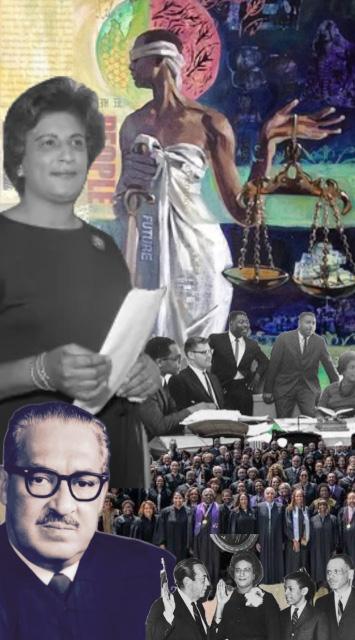
For many years, Black professionals have fought tooth and nail to reach the same level of success in the legal field as their non-black counterparts. Despite their commitment, they have encountered many different obstacles, such as restricted access to employment, promotion, and mentorship. The lack of representation in legal schools and firms makes breaking these barriers more difficult. To combat these odds, two organizations were established to alleviate the stressors that plagued our community: The National Bar Association (NBA) and the NAACP Legal Defense Fund (LDF). These two organizations aimed for Black representation in the legal field and advance civil rights through legal advocacy. Together, these organizations have helped pave the way for millions of Black attorneys by increasing representation in the legal field, and they continue to do so to this day.
The Beginnings
During the ‘separate but equal’ times of America, discrimination based on race was at its peak, and the legal field was no exception to this practice. The American Bar Association (ABA) openly ignored and discriminated against aspiring Black attorneys by means such as exclusion from membership, racially segregated law schools, and exclusion of black attorneys from high-profile law firms. This inhibited Black professionals from acquiring careers in the field (Smith). As a result, twelve Black lawyers met in Des Moines, Iowa, to establish the National Bar Association. This would mark a great victory for Black professionals by presenting a free space for networking and practicing a commitment to equal rights and justice.
Similarly, the NAACP Legal Defense Fund came about during a time when the nation was still encouraging racial disparity and injustice. Founded in 1940 by Thurgood Marshall, the first African-American U.S. Supreme Court Justice, the LDF is the first civil and human rights law firm established in the United States that was dedicated to fighting for racial justice, equality, and civil rights through legal action, advocacy, and education. Landmark Victories
The LDF was instrumental in cultivating the legal strategy that brought about the landmark decision in the Brown v. Board of Education (1954) case (Tauber). Thurgood Marshall himself helped spearhead the many campaigns over almost two decades to ensure that the Supreme Court would overturn the decision made in the Plessy v. Ferguson (1886) case. The LDF has also played enormous roles in cases such as Swann v. Charlotte-Mecklenburg Board of Education (1971), which called for using busing to help desegregate schools, and Cooper v. Aaron (1958), which helped to enforce the ruling for Brown v. Bd. of Education. The National Bar Association and the LDF also ensured that many civil rights laws were passed, including the Elementary and Secondary Education Act, the Fair Housing Act, the Voting Rights Act, and the Civil Rights Act of 1964 (Legal Defense Fund). The Fight Persists
Despite their achievements, both the NBA and the LDF still face enduring problems, such as systematic discrimination and the underrepresentation of Black professionals in the legal industry. These organizations actively cooperate with other civil rights organizations, such as the National Urban League and Southern Poverty Law Center (SPLC), to address these issues and advance legislative and policy changes that advance racial justice. Voter suppression legislation and attempts to discredit affirmative action remain significant obstacles that call for persistent political and legal fights. However, J. Clay Smith, author of The Black Bar Association and Civil Rights, tells us, “The survival of the Black lawyer required association and scholarship.” The survival of “colored citizens” required Black lawyers capable of judicial agitation and creative jurisprudential thought.” These remarks highlight Black attorneys’ crucial role in opposing injustices and promoting significant change.
Conclusion
The fight for justice persists, and these organizations remain essential in ensuring the legal system works for all. Black attorneys have successfully established strong advocacy platforms, guaranteeing their opinions are heard in the fight for justice and equality. The legacy of these establishments is a testament to the perseverance and resilience of the communities they represent, overcoming challenges and shaping a lasting impact on future generations.
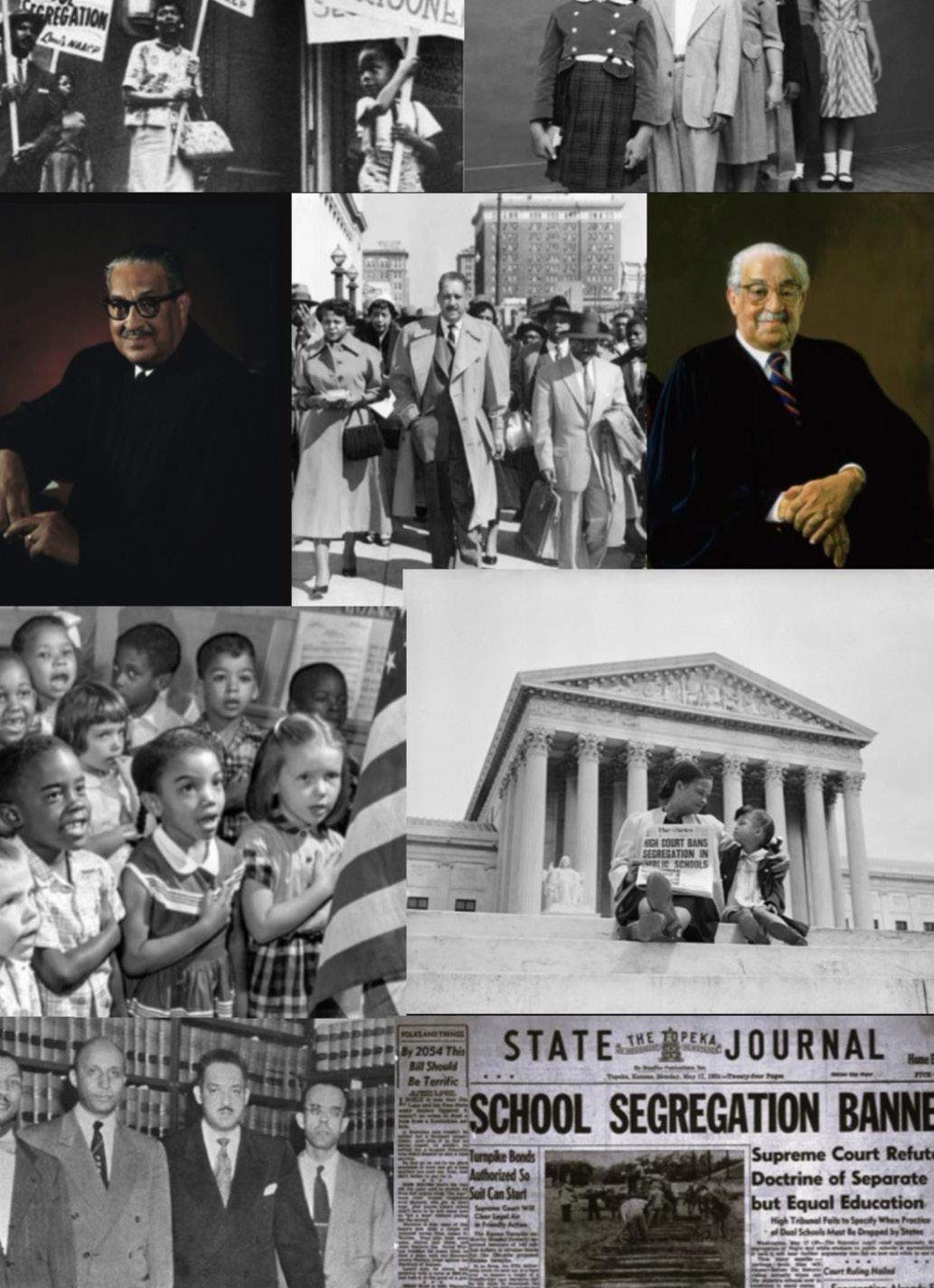
By Devin Anderson
On January 20th, 2021, Kamala Harris, senator from California, took the oath of office in the U.S. Capitol to become the first African American Woman Vice President of the United States. When sworn in as Vice President, she used two Bibles for her oath. One of them belonged to a man who founded the NAACP Legal Defense Fund and inspired a generation, including Harris’, “to embrace the law as a means to advancing equality and justice” (Jealous & Florida Courier, 2024).
Background: Marshall’s Upbringing
Thurgood Marshall, born in 1908 in Baltimore, Maryland, was a high-achieving student who grew up during a time of segregation. Even though Marshall grew up and lived in the United States when segregation was at its highest point, that did not deter him from becoming a high-achieving student. He graduated from Lincoln University in 1930 and later Howard University, where he earned his law degree in 1933 (History, 2009). Marshall won his first court case in 1935, Murray v. Pearson, and worked as a staff attorney for the NAACP (Britannica, 2000). He rose to prominence in the 1940s and 1950s, winning 29 of 32 Supreme Court cases. However, one case Marshall would argue before the Supreme Court would mark an important turning point in his career and permanently change the course of American history: Brown v. Board of Education of Topeka (1954).
Brown V. Board of Education
Brown v. Board of Education (1954) was a landmark Supreme Court case that challenged the legality of racial segregation in public schools. Under Jim Crow laws, African Americans faced widespread discrimination and segregation in all aspects of life, upheld by the Supreme Court’s Plessy v. Ferguson (1896) ruling, which established the “separate but equal” doctrine Oyez, 2025). Led by NAACP attorney Thurgood Marshall, the case argued that segregation harmed Black children psychologically and violated the Equal Protection Clause of the 14th Amendment. Using extensive research and psychological studies, “quoting from more than 29 different scientific sources to support his claim that school segregation kept children from achieving their potential” (Plyer, 2003), Marshall proved that separate educational facilities were inherently unequal. In a unanimous 9-0 decision, the Court overturned Plessy, ruling that segregation in public schools was unconstitutional. This decision was a turning point in the Civil Rights Movement, inspiring activism that led to the Civil Rights Act of 1964, the Voting Rights Act of 1965, and the Fair Housing Act of 1968, ultimately dismantling legalized segregation in the United States (History, 2009).
Conclusion
As a leader who is often foreshadowed in African American history, Marshall played a crucial role in the Civil Rights movement with his visionary legal work that helped end segregation in the United States. His leadership in this case established the foundation for his future achievements as a Justice of the Supreme Court, inspired African Americans to pursue careers in politics such as Kamala Harris, and most importantly solidified his reputation as a pivotal figure in American history. With the historic unanimous decision in Brown v. Board of Education, Marshall’s legal arguments and grit not only ended segregation but also cleared the path for subsequent civil rights victories. Thurgood Marshall’s work in this case remains a beacon of hope and progress in the ongoing fight for equality and justice.

By Bobbie Patton
One cloudy day in 1934, hundreds of Harlem residents gathered in a downtown apartment building. Cold, hungry, and tired, the protesters returned day after day to sit in protest of evictions in their low-income neighborhood. All over the city, demonstrations like these were happening as a part of a larger effort to reclaim the rights of the working class. Rising rents were slowly pushing people out of their homes. Coupled with racial discrimination, Black Harlem dwellers felt the brunt of these attacks, where a city that had already attempted to make them feel unwelcome was also driving them away. This, in turn, led people to adopt strategies of the Communist Party in Harlem. The Communist Party largely influenced the formation of organized tenant unions, such as the Harlem Unemployed Council, which was responsible for leading these demonstrations (Harrison 2021). In the modern day, we would refer to this phenomenon as gentrification, and its devastating impact still persists today. The Harlem protesters were eventually successful in winning back their rights in the form of new legal protections against discrimination. Today, however, Black communities all over the country find themselves dealing with the same struggles as the civil rights-era folks in Harlem. By turning to the past, we can gain insight into how we can preserve our communities for generations to come.
In 2025, most people in the U.S. are familiar with the term gentrification. Coined by sociologist Ruth Glass, gentrification describes a process in which low-income residents of an area are displaced, and wealthier residents repopulate their former spaces (Brown-Saracino 2013). In the U.S., gentrification operates as both a class and racial issue, in which working-class communities of color are often displaced from their neighborhoods. Gentrification can have devastating effects on individuals and their families. Long-standing mom-and-pop businesses are replaced by corporate entities, barring regular people from building generational wealth. In this socio-economic climate, we are faced with story after story of family businesses being replaced by luxury high-rise apartments. It is, however, important to remember that communities do have autonomy over what happens to them. Often, discussions around gentrification frame the act as a political inevitability, an unstoppable force solidified at the inception of racial capitalism. There are examples, though, of successful community efforts that have resisted gentrification all throughout history. In the face of greedy corporations and power-hungry politicians aiding in their removal, many of these grassroots movements have nonetheless prevailed.
Richard
Harlem Tenants League
Throughout history, a few figures have emerged whose philosophies are applicable to the current efforts. Born and raised in Barbados, Richard Moore was an active community member in 1920s Harlem. In his early days, Moore was a member of the Communist Party and one of the main advocates for Black inclusion within those spaces (Harrison 2021). Revolutionaries such as Moore and later Fred Hampton believed integration based on common interest was the key to gaining power in a movement (Elizee 1994). Moore was a main leader in bringing the communist party to segregated Harlem. These ideas quickly gained traction. The oppressed people of the neighborhood recognized the need for change and joined local efforts en masse. In 1928, Richard Moore founded The Harlem Tenants League along with fellow organizer Grace Campbell (Elizee 1994). Their primary objective was to pressure the city to implement rent control policies for Harlem’s residents. The league organized rent strikes as well as protests outside of the former Board of Alderman for better living conditions. Many of the league’s strategies were adopted by larger movements during The Great Depression (Roberts 2023). Unfortunately, this led to the erasure of the Black spearheads of these movements, and history remembers the rent strike as a mostly white affair. The Harlem Tenants League succeeded in bringing forth the Civil Practice Act, a law that improved living conditions and stabilized rent for Harlem dwellers (Roberts, 2023). For a population facing legal discrimination, state-sponsored violence, and gentrification simultaneously, this case was a landmark movement for people’s uprisings.
Conclusion
When approaching gentrification today, the news we see is mostly negative. It is certainly discouraging to see the erasure of so much Black history and culture within our neighborhoods. However, we can look to the past to defend ourselves and our present existence. Richard Moore and his contemporaries took powerful, actionable steps regarding tenant rights. Many of these steps still have ramifications today. Tenant organizations still exist in most communities, and any local community member is eligible to participate. In California in 2024, a rent control measure, Prop 33, was on the ballot. Gentrification may seem inevitable, but we, as Black people, community members, and neighbors, have the power to resist.
Tug o War Revelations: Precious Alagba
Acholonu, I. (2022) Why Malcolm X’s critique on Colonial Africa Matters Today, LSE International Development. Available at: https://blogs.lse.ac.uk/internationaldevelopment/2022/06/24/why-malcolm-xscritique-on -colonial-africa-matters-today/ (Accessed: 08 February 2025).
Cincotta, R. (2021) Thomas Sankara’s Lost Legacy, Wilson Center. Available at: https://www.wilsoncenter.org/ blog-post/thomas-sankaras-lost-legacy (Accessed: 08 February 2025).
Goshu, S. (2016) In memory of Patrice Lumumba, The Reporter Ethiopia. Available at: https://www.thereporterethiopia. com/4185? (Accessed: 09 February 2025).
Harsch, E. (2023) Thomas Sankara: How the leader of a small African country left such a large footprint, E-International Relations. Available at: https://www.e-ir.info/2023/11/12/thomas-sankara-how-the-leader-of-a-smallafrican-coun try-left-such-a-large-footprint/#google_vignette (Accessed: 08 February 2025).
Pittman, J.P. (1992) Double Consciousness, Stanford Encyclopedia of Philosophy. Available at: https://plato.stanford. edu/entries/double-consciousness/ (Accessed: 09 February 2025).
Segantini, M. (2023) The Inextinguishable Legacy of Patrice Lumumba. Available at: https://www.john-adams. nl/wp-content/uploads/2023/12/SHORTLISTED-Marco-Segantini _Patrice-Lumumbas-Political-Career.pdf (Accessed: 10 February 2025).
X, M. (1964) Malcolm X on Lumumba, World History Archive. Available at: http://www.hartford-hwp.com/ archives/45a/459.html (Accessed: 08 February 2025).
The Lasting Impact of Alpha Kappa Alpha on the 2024 Election by A’shiyah Dobbs
Alpha Kappa Alpha Sorority, Inc (2024a). Alpha Kappa Alpha Sorority, Inc. - About. [online] Alpha Kappa Alpha Sorority, Inc. Available at: https:// aka1908.com/about/.
Alpha Kappa Alpha Sorority, Inc (2024). Alpha Kappa Alpha Sorority, Inc. - History. [online] Alpha Kappa Alpha Sorority, Inc. Available at: https:// aka1908.com/about/history/. Gibson, J. (2025), Interviewed by A’shiyah Dobbs. 8 February, Los Angeles.
A Fight Against Gentrification: A Historical Counter Perspective by Bobbie Patton
Brown-Saracino, Japonica. “Gentrification.” Oxford Bibliographies Online Datasets, January 28, 2013. https://doi. org/10.1093/obo/9780199756384-0074. City of Winston-Salem. “Winston-Salem Anti-Displacement Policy Recommendations.” City of Winston-Salem. Accessed 1/28/25. https://www.cityofws.org/DocumentCenter/View/20589/Winston-Salem-Anti-Displacement-Policy-Recommendations.
Elizee, Andre. “Richard B. Moore papers, Sc MG 397.” Schomburg Center for Research in Black Culture, Manuscripts, Archives and Rare Books Division, The New York Public Library, 1994. Accessed 1/25/25. https://archives.nypl.org/ scm/20575.
Frazier, Nishani. “Breonna Taylor and Gentrification: It’s No Mere Claim.” AMSJ Blog, October 11, 2022. https:// amsj.blog/2022/10/11/breonna-taylor-and-gentrification-its-no-mere-claim/ Harrison, Sasha. “Harlem’s 1930s Housing Struggle Has Lessons for Today.” Liberation News. Accessed 1/25/25. https://www.liberationnews.org/harlems1930s-housing-struggle-has-lessons-fortoday/.
Miami University Libraries. “The Gentrification Project.” Miami University. Accessed 10/11/24. https://gentrificationproject.lib.miamioh.edu/.
Pacific University. “Proposition 33: The Justice for Renters Act (2024).” Pacific University. Accessed 1/25/25. https:// www.pacific.edu/sites/default/files/users/ user242/proposition-33-2024.pdf.
Roberts, Sam. New York Times. “Bill Perkins, Harlem Councilman and State Senator, Dies at 74.” The New York Times, May 19, 2023. https://www. nytimes.com/2023/05/19/nyregion/billperkins-dead.html.
San Diego Union-Tribune. “Assemblywoman Shirley Weber on the Issues.” San Diego Union-Tribune, October 16, 2018. https://www.sandiegouniontribune. com/2018/10/16/assemblywoman-shir-
A Comprehensive Look at Racialized Space in the United States and Its Ongoing Impact on African Americans
Parallel Pursuits of Justice by Anna James
By Anthony Lewis
“Legal Timeline - The Civil Rights Act of 1964: A Long Struggle for Freedom | Exhibitions - Library of Congress,” October 10, 2014. https://www.loc.gov/ exhibits/civil-rights-act/legal-events-timeline.html.
“History.” Legal Defense Fund, 9 Aug. 2022, www.naacpldf.org/about-us/history/. “Home.” National Bar Association, 6 Jan. 2025, nationalbar.org/.
“A History of Residential Segregation in the United States” 34, no. 4 March, 2019.
Straighten Your Hair, It’s More Professional: The Policing of Black Hairstyles in Professional Settings By Yadeal Asfaw & Dorothea Amadin
Thurgood Marshall & Brown v Board of Education by Devin Anderson
Amir Vera, Family of the black wrestler who was forced to cut his dreadlocks speaks out CNN (Dec. 26, 2018).
www.cnn.com/2018/12/25/us/wrestler-dreadlocks-new-jersey-comments/index.html
Legacy Of Slavery By A’shiyah Dobbs Patterson, Orlando. Slavery and Social Death. Harvard University Press, 1982. Wilkerson, Isabel. Caste: The Origins of Our Discontents. Thorndike Press Large Print, 2021.
National League of Cities. “Housing for Black-Led Households,” February 6, 2024. https://www.nlc.org/ article/2024/02/06/housing-for-black-led-households/.
Smith Jr, J. Clay. “The Black Bar Association and Civil Rights.” Creighton L. Rev. 15 (1981): 651.
Jealous, B., & Florida Courier. (2024, September 13). The figures who helped shape Vice President Harris. https://www.flcourier.com/commentaries/the-figures-whohelped-shape-vice-president-harris/arti cle_bab80138-71dc11ef-b2f4-d3dce14122ad.html
EEOC v. Catastrophe Management Solutions 852 F.3d 1018 (11th Cir. 2016)
Jones, Elizabeth. “Racism, fines and fees and the US Carceral State.” Race & Class, vol. 59, no. 3, 9 Oct. 2017, pp. 38–50, https://doi.
“USHMC 95: Public Housing: Image Versus Facts.” Accessed April 20, 2024. https://www.huduser.gov/periodicals/ushmc/spring95/ spring95.html.
Tauber, Steven C. “The NAACP Legal Defense Fund and the US Supreme Court’s racial
5 Gorenflo, Neal. “Timeline of 100 Years of Racist Housing Policy That Created a Separate and Unequal America.”
Shareable, October 31, 2019. https://www.shareable. net/timeline-of-100-years-of-racist-housing-policythat-created-a-separate-and-unequal-ameri ca/.
“Public Housing History | National Low Income Housing Coalition,” April 8, 2024.
Weisburd, David, Anthony A Braga, and Phillip Atiba Goff. “COMMITTEE ON PROACTIVE POLICING: EFFECTS ON CRIME, COMMUNITIES, AND CIVIL LIBERTIES,” 2018.
9“The Criminalization of Public Housing Residents.” Accessed April 20, 2024. https://www.law.georgetown.edu/poverty-journal/blog/ the-criminalization-of-public-housing-residents/.
8 FRONTLINE. “Michelle Alexander: ‘A System of Racial and Social Control.’” Accessed April 20, 2024. https://www.pbs.org/wgbh/frontline/article/michelle-alexander-a-system-of-racial-and-social-control/.
7Initiative, Prison Policy. “Race and Ethnicity.” Accessed April 20, 2024.
11 The Commonwealth Institute. “Unequal Opportunities: Fewer Resources, Worse Outcomes for Students in Schools with Concentrated Poverty.” Accessed April 20, 2024. https://thecommonwealthinstitute.org/research/ unequal-opportunities-fewer-resources-worse-outcomes-for-studentsin-schools-with-concentrated-poverty/.
“The Right to Remain a Student: How CA School Policies Fail to Protect and Serve | ACLU of Northern CA.” Accessed April 20, 2024. https://www.aclunc.org/ publications/right-remain-student-how-ca-school-policies-fail-protect-and-serve.
Kotlowitz, Alex. 1992. There Are No Children Here : The Story of Two Boys Growing up in the Other America / Alex Kotlowitz. First Anchor books edition. New York: Anchor Books.
Jill Billante & Chuck Hadad, Study: White and Black children biased toward lighter skin CNN (2010, May 14).
History. (2009, October 29). Thurgood Marshall. History. https://www.history.com/topics/black-history/thurgood-marshall
www.cnn.com/2010/US/05/13/doll.study/index. html
Smentkowski, B. P. (2000, January 12). Thurgood Marshall | Biography, Legal Career, Supreme Court Tenure, & Facts. Britannica. https://www.britannica.com/biography/Thurgood-Marshall
JOY Collective, C.R.O.W.N. Research Study, DOVE, (2019)
static1.squarespace.com/static/5edc69fd622c36173f56651f/t/5edeaa2fe5ddef345e087361 /1591650865168/Dove_research_brochure2020_FINAL3.pdf
Schraub, David. “Post-Racialism and the End of Strict Scrutiny.” Academia.Edu, 29 Mar. 2018, www.academia.edu/23753873/ Post-Racialism_and_the_End_of_Strict_ Scrutiny.
Los Angeles County Superior Court. People of the State of California vs. Daystar Peterson. org/10.1177/0306396817734785.
Plessy v. Ferguson. (2025). Oyez. Retrieved January 8, 2025, from
https://www.oyez.org/cases/1850-1900/163us537
History. (2009, October 27). Brown v. Board of Education. History.
Leigh Alexander, Do Google’s ‘unprofessional hair’ results show it is racist? THE GUARDIAN (Apr. 8, 2016), www.theguardian.com/technology/2016/apr/08/ does-google-unprofessional-hair-results-p
https://www.history.com/topics/black-history/brown-vboard-of-education-of-topeka
rove-algorithms-racist-
Renee Henson, Are my Cornrows Unprofessional?: Title VII’s Narrow Application of Grooming Policies, and its Effect on Black Women’s Natural Hair in the Workplace, 1 BUS.
4. Schraub, David. “Post-Racialism and the End of Strict Scrutiny.” Academia.Edu, 29 Mar. 2018, www. academia.edu/23753873/Post-Racialism_and_the_End_of_Strict_ Scrutiny.
5.Los Angeles County Superior Court. People of the State of California vs. Daystar Peterson.
Plyer, A. (2003, February 07). Thurgood Marshall Scientific evidence supported his case against segregation. https:// www.datacenterresearch.org/pre-katrina/articles/integration. html
ENTREPRENEURSHIP & TAX L. REV. 521 (2017). scholarship.law.missouri.edu/betr/vol1/iss2/9
S.B.188, 2019 Regular Session. (CA 2019).
Front & Back Cover Page
Photographer: Andrew Blair
Model: Kiara Gibbs-Cawker
Table of Contents
Credit: Stock Images
Tug o War Revelations: Alana Akiwumi
Africa unites - @leftaesthetic
https://pin.it/4ToqFV7Fl
Black and white contrast figures (hippe tattoo)
https://pin.it/3FQNdfcvI
Resource map of Africa Tysir Salih on Instagram: ““Underdevelopment is a paradox
https://pin.it/2Zu2AJlcU
Group of Children
Olivia Montaltohttps://pin.it/62plGyvyA
Puzzle piece eye-chenyanli7166
https://pin.it/6rk6AqgUa
Malcolm X Silhouette Large Wall Decal
https://pin.it/3LAVfwaUU
Full Tug of War stance & placement references
https://pin.it/6TyRH3AHG
Patrice Lumumba Poster
https://pin.it/18xT6PM9c
The Lasting Impact of the AKA on the 2024 Election: Ure Egu
The Wall Street Journal
How Kamala Harris’s Alpha Kappa
Alpha Sorority Sisters Sprang to Action
https://www.pinterest.com/ pin/360850988897136126
Jennifer Brooks
Lovely Sorors
https://www.pinterest.com/ pin/66920744456943408
Diva1908Terrrell
#Epsilon Nu# 1976# Alpha Kappa
Alpha Philadelphia, Pennsylvania
https://www.pinterest.com/ pin/459156124479998408
Caj.
Alpha Kappa Alpha
https://www.pinterest.com/ pin/480688960207346028
[Black Woman Emoji]
Vintage Images of Alpha Kappa
Alpha
https://www.pinterest.com/ pin/65625897698021690
UCLA Alpha Gamma Chapter 2024
Credit: Jada Gibson
A Fight Against Gentrification: Ure Egu
D.C. Public Libraries To Host Exhibitions On Neighborhood Gentrification
https://wamu.org/story/19/04/08/d-c-public-libraries-to-host-exhibitions-on-neighborhood-gentrification/ Ruth Silvers
Harlem
https://www.pinterest.com/ pin/721913015307514105/ Kamala Eaton ‘https://www.pinterest.com/pin/543598617542724823/ feedback/?invite_code=fa23f0ac483f49839865f0cd385e5a08&sender_ id=1097189665376635553
Urban Intellectuals
Did You Know Black Ghettos Were Deliberately Created By Gov’t Sponsored Redlining? https://www.pinterest.com/ pin/58757970119112644/feedback/?invite_code=6c5ab181e9d540c4bf7aa6f8eddc1aff&sender_id=1097189665376635553
Portraits Of Harlem
https://www.pinterest.com/ pin/721913015307514124/
A Comprehensive Look at Racialized Space in the United States and Its Ongoing Impact on African Americans
Parallel Pursuits of Justice: Anna James
By Anthony Lewis
Ash White (author) https://www.pinterest.com/ pin/721913015307512317/
“Legal Timeline - The Civil Rights Act of 1964: A Long Struggle for Freedom | Exhibitions - Library of Congress,” October 10, 2014. https://www.loc.gov/ exhibits/civil-rights-act/legal-events-timeline.html.
“A History of Residential Segregation in the United States” 34, no. 4 March, 2019.
National League of Cities. “Housing for Black-Led Households,” February 6, 2024. https://www.nlc.org/ article/2024/02/06/housing-for-black-led-households/. “USHMC 95: Public Housing: Image Versus Facts.” Accessed April 20, 2024. https://www.huduser.gov/periodicals/ushmc/spring95/ spring95.html.
Straighten Your Hair, It’s More Professional: The Policing of Black Hairstyles in Professional Settings By Yadeal Asfaw & Dorothea Amadin
Thurgood Marshall & Brown v Board of Education: Shelby Solomon
Kalen Tims 010
Amir Vera, Family of the black wrestler who was forced to cut his dreadlocks speaks out CNN (Dec. 26, 2018).
Legacy Of Slavery By A’shiyah Dobbs Patterson, Orlando. Slavery and Social Death. Harvard University Press, 1982. Wilkerson, Isabel. Caste: The Origins of Our Discontents. Thorndike Press Large Print, 2021.
Legal Defense Fund (title) https://www.pinterest.com/ pin/721913015307452515/ Biography of Thurgood Marshall, First Black Supreme Court Justice (title) https://www.pinterest.com/ pin/721913015307452664/ The Evidence of Things Unsaid (title)
www.cnn.com/2018/12/25/us/wrestler-dreadlocks-new-jersey-comments/index.html
Brown v. Board of Education https://pin.it/2wUDUnQEw (https://pin.it/2wUDUnQEw)
Rachel Schlock
EEOC v. Catastrophe Management Solutions 852 F.3d 1018 (11th Cir. 2016)
Jill Billante & Chuck Hadad, Study: White and Black children biased toward lighter skin CNN (2010, May 14).
Jones, Elizabeth. “Racism, fines and fees and the US Carceral State.” Race & Class, vol. 59, no. 3, 9 Oct. 2017, pp. 38–50, https://doi.
60 years ago Brown v. Board of Education https:// pin.it/1mRutueyb (https://pin.it/1mRutueyb)
Miss Summer
5 Gorenflo, Neal. “Timeline of 100 Years of Racist Housing Policy That Created a Separate and Unequal America.”
Shareable, October 31, 2019. https://www.shareable. net/timeline-of-100-years-of-racist-housing-policythat-created-a-separate-and-unequal-ameri ca/.
“Public Housing History | National Low Income Housing Coalition,” April 8, 2024.
www.cnn.com/2010/US/05/13/doll.study/index. html
Thurgood Marshall- Movie and Education https:// pin.it/7jwqsDHEs (https://pin.it/7jwqsDHEs)
Schraub, David. “Post-Racialism and the End of Strict Scrutiny.” Academia.Edu, 29 Mar. 2018, www.academia.edu/23753873/ Post-Racialism_and_the_End_of_Strict_ Scrutiny.
JOY Collective, C.R.O.W.N. Research Study, DOVE, (2019)
Jeffry Jackson ’06https://pin.it/1fqsGJUMZ (https://pin.it/1fqsGJUMZ)
Al Simmons
Weisburd, David, Anthony A Braga, and Phillip Atiba Goff. “COMMITTEE ON PROACTIVE POLICING: EFFECTS ON CRIME, COMMUNITIES, AND CIVIL LIBERTIES,” 2018.
Smithsonian National Museum of African American History and Culture (author) https://www.pinterest.com/ pin/721913015307452525/ Judge Ketanji Brown Jackson (title) https://www.pinterest.com/ pin/721913015307493521/
static1.squarespace.com/static/5edc69fd622c36173f56651f/t/5edeaa2fe5ddef345e087361 /1591650865168/Dove_research_brochure2020_FINAL3.pdf
Los Angeles County Superior Court. People of the State of California vs. Daystar Peterson. org/10.1177/0306396817734785.
Thurgood Marshall a True Champion https://pin. it/6Gcby2dYZ (https://pin.it/6Gcby2dYZ)
Taylor Francis
9“The Criminalization of Public Housing Residents.” Accessed April 20, 2024. https://www.law.georgetown.edu/poverty-journal/blog/ the-criminalization-of-public-housing-residents/.
National Bar Association (Title) https://en.wikipedia.org/wiki/National_Bar_Association
8 FRONTLINE. “Michelle Alexander: ‘A System of Racial and Social Control.’” Accessed April 20, 2024. https://www.pbs.org/wgbh/frontline/article/michelle-alexander-a-system-of-racial-and-social-control/.
Leigh Alexander, Do Google’s ‘unprofessional hair’ results show it is racist? THE GUARDIAN (Apr. 8, 2016), www.theguardian.com/technology/2016/apr/08/ does-google-unprofessional-hair-results-p rove-algorithms-racist-
Judicial Council (Title) https://www.nbajudicialcouncil.org/about
7Initiative, Prison Policy. “Race and Ethnicity.” Accessed April 20, 2024.
Cory Booker one Instagram https://pin.it/6Gcby2dYZ (https://pin.it/6Gcby2dYZ)
Kimberly Gaddy
4. Schraub, David. “Post-Racialism and the End of Strict Scrutiny.” Academia.Edu, 29 Mar. 2018, www. academia.edu/23753873/Post-Racialism_and_the_End_of_Strict_ Scrutiny.
5.Los Angeles County Superior Court. People of the State of California vs. Daystar Peterson.
Look: Iconic Photos Taken After The Brown v . Board of Education Decision https://pin.it/3FobAsRDM (https://pin.it/3FobAsRDM)
Brewminate
Renee Henson, Are my Cornrows Unprofessional?: Title VII’s Narrow Application of Grooming Policies, and its Effect on Black Women’s Natural Hair in the Workplace, 1 BUS.
National Bar Association Announces “40 Under 40” Award Recipients Announced (Title) https://www.dogonvillage.com/2019/06/ national-bar-association-announces-40-under-40-award-recipients-announced/ NAACP Legal Defense and Educational Fund (1940- ) (title)
11 The Commonwealth Institute. “Unequal Opportunities: Fewer Resources, Worse Outcomes for Students in Schools with Concentrated Poverty.” Accessed April 20, 2024. https://thecommonwealthinstitute.org/research/ unequal-opportunities-fewer-resources-worse-outcomes-for-studentsin-schools-with-concentrated-poverty/.
“The Right to Remain a Student: How CA School Policies Fail to Protect and Serve | ACLU of Northern CA.” Accessed April 20, 2024. https://www.aclunc.org/ publications/right-remain-student-how-ca-school-policies-fail-protect-and-serve.
ENTREPRENEURSHIP & TAX L. REV. 521 (2017). scholarship.law.missouri.edu/betr/vol1/iss2/9
S.B.188, 2019 Regular Session. (CA 2019).
Susan Bragg (author) https://www.blackpast.org/african-american-history/naacp-legal-defense-and-educational-fund-founded-1940/
Unsolved Matters: Brown v. Board of Education of Topeka in 1954 https://pin.it/2cZE12Qme (https://pin. it/2cZE12Qme)
Kotlowitz, Alex. 1992. There Are No Children Here : The Story of Two Boys Growing up in the Other America / Alex Kotlowitz. First Anchor books edition. New York: Anchor Books.
NAACP Legal Defense Fund (author)
Podcast with Jack Greenberg (title) https://www.scotusblog.com/2010/02/podcastwith-jack-greenberg/
NAACP Legal Defense Fund launches program to educate and train next generation of civil rights attorneys (title)
Melanie Paulick | Duquesne U. School of Law, US (author) https://www.jurist.org/news/2021/01/naacp-legal-defense-fund-launches-program-to-educateand-train-next-generation-of-civil-rights-attorneys/
